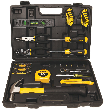Have you ever found yourself in need of a new outlet, light switch, or some other kind of electrical box? This is a common enough problem to find yourself faced with, particularly when you are installing a new ceiling fan, or other kind of light system. Luckily, installing cut-in boxes is a fairly simple procedure. Cut-in boxes (also known as remodeling boxes) are the type of electrical boxes that you use when you are working with an already finished wall. Usually, the biggest problem that you are faced with when doing this kind of work is that different methods are used for installation depending on the type of cut-in box. Here are a few of the more common types of cut-in boxes that you can use, and how to install them.
Before beginning this project though, keep in mind that you should always turn off the power to the wall that you will be working on. The best way that you can do this is by shutting off the power at the circuit breaker box. Just remember to leave a note saying to leave the power off, incase anyone comes along while you are working. This will help reduce, or even eliminate, the possibility of accidents.
- Cut a hole. Regardless of what kind of cut-in box you install, you will need to first cut a hole into the wall. Mark the location that you want your cut-in box installed in by using a pencil. After you have chosen a spot, double check to make sure that there are no studs in the way. Either make a template of your cut-in box (made from cardboard) or the actual cut-in box up to the mark on the wall. Trace the outline of the box using a pencil, and then begin to cut the hole. You can cut this hole one of three ways. These methods are either by using a drywall saw, a spiral cutting tool, or even using a saber saw. Spiral cutting tools are perfect for working on plaster and lathe walls, since it will not loosen the plaster or the lathe.
- Spring flanged boxes. Before installing this box, test to make sure that the flanges will spring out from the box when they are pressed down. If they do, go ahead and press the flanges against the box, and place the box into the hole. Push back on the box until the flanges are free to come out. When they do, begin to tighten the center screw until the box cannot be easily moved.
- Side clamped boxes. Once you have placed the box into the hole, begin tightening the screws on its side. As you tighten each of the screws, a flange will begin to extend from the side of the box, holding it in place. Continue tightening the screws until you cannot easily move the box any more.
- Mounting brackets. Typically the only cut-in box that will require mounting brackets are the ones that have plaster ears. Place this box into the hole, and then slip a bracket in behind it on each side. Once both brackets are in place, pull them towards you gently but firmly until it is tightly in place. Now, push the box itself against the wall, and fold the tabs into the box. Use some pliers to help tighten the tabs.
- Fold-out ears. Boxes that have fold-out ears are perfect for ceilings. These boxes usually have some type of plastic ears that will fold out behind the drywall to help hold it in place. Push the box into the hole, and then begin turning the screws clockwise. Continue to turn the screws until you cannot turn them anymore, since this will signify that the ears have fully extended.
Author Bio
Lee Wyatt
Contributor of numerous Tips.Net articles, Lee Wyatt is quickly becoming a regular "Jack of all trades." He is currently an independent contractor specializing in writing and editing. Contact him today for all of your writing and editing needs! Click here to contact. Learn more about Lee...
Passing Traffic Safely
One of the reasons for traffic accidents is improper passing procedures. Here is how you can reduce the likelihood of ...
Discover More
Cleaning Stained Hearths
Whenever the weather begins to get a little colder, or you are looking for a romantic evening, thoughts naturally begin ...
Discover More
How to Check Your Brake Fluid
Too many people go by without checking their brake fluid themselves, and leave it for their periodic tune up. Instead of ...
Discover More
More Home Improvement Tips
Choosing Bathroom Light Fixtures
For some reason, the bathroom tends to be one of the most overlooked rooms in the home when it comes to interior ...
Discover More
How to Read Your Electric Meter
Have you ever wondered how to read your electric meter? Well, it's not all that difficult, and you can even track your ...
Discover More
Outdoor Lights
Outdoor lights are a necessity around the home for many different reasons. Some of these reasons include being able to ...
Discover More

Comments